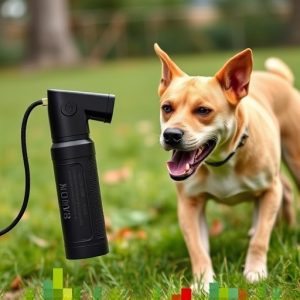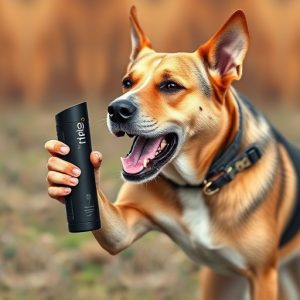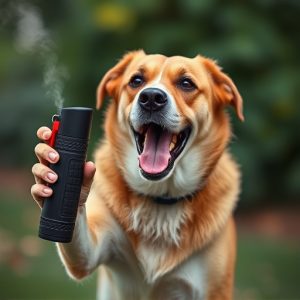Mastering Mace Spray: Effective Dog Attack Defense & Training Techniques
Dog aggression, driven by fear or protective instincts, requires understanding and managing triggers…….
Dog aggression, driven by fear or protective instincts, requires understanding and managing triggers. Mace spray, a last-resort defense tool, is effective when properly trained. This involves desensitizing dogs to mace, positive reinforcement for calm behavior, and controlled practice scenarios. Legal considerations and safety precautions, including local regulations and gear use, are vital for responsible mace spray deployment. Proper training ensures dogs respond appropriately, prioritizing canine and human safety during potential attacks.
In the face of dog attacks, understanding canine aggression and employing effective defense mechanisms is paramount. This article explores a powerful tool in your arsenal: mace spray. We delve into the science behind dog behavior, highlighting aggressive triggers and attack patterns. Subsequently, we uncover how proper mace spray techniques can deter and protect against these threats. Learn about safe training strategies to ensure you and your loved ones are prepared, while navigating legal considerations for responsible mace spray use on dogs.
- Understanding Dog Aggression and Attack Behavior
- The Role of Mace Spray in Canine Defense
- Effective Training Strategies for Using Mace Spray with Dogs
- Legal Considerations and Safety Precautions for Mace Spray Use on Dogs
Understanding Dog Aggression and Attack Behavior
Dog aggression can stem from various factors, including fear, territorial behavior, or even protective instincts. Understanding these triggers is key to preventing and managing potential attacks. When a dog feels threatened, it may exhibit defensive behaviors like growling, barking, or lunging, which, in extreme cases, can escalate into physical aggression. Proper mace spray dog training techniques can help mitigate such situations.
Training your dog using positive reinforcement methods can teach them alternative responses to triggers. This involves identifying the warning signs of aggression and redirecting their focus with commands like “sit” or “stay.” Additionally, practicing proper mace spray application in controlled settings ensures that both the dog and its owner are prepared for unexpected encounters, enhancing safety during potential attacks.
The Role of Mace Spray in Canine Defense
Mace spray, when used correctly, can be a powerful tool for dog attack defense. It’s a non-lethal option that can disable an aggressive dog long enough to escape or seek help. However, it’s crucial to understand that mace is not a replacement for proper dog training techniques. Owners need to be skilled in using mace spray appropriately and responsibly, ensuring they deploy it only as a last resort when facing an imminent threat from a dog.
The effectiveness of mace spray depends heavily on the owner’s ability to properly identify and assess the situation. Factors like distance, angle, wind, and the size and aggression level of the dog play a significant role in its success. Proper mace spray dog training techniques involve learning safe handling practices, understanding trigger distances, and practicing deployment under controlled conditions to ensure both the safety of the owner and any bystanders.
Effective Training Strategies for Using Mace Spray with Dogs
Training a dog to respond appropriately when faced with mace spray is crucial for both canine and human safety during potential attacks. The first step involves desensitizing the dog to the scent and feel of mace, starting with diluted solutions and gradually increasing strength over several sessions. Positive reinforcement techniques, such as rewarding calm behavior or specific commands, can help dogs associate the spray with a positive outcome, like a treat or praise.
During training, it’s essential to practice in controlled environments that mimic potential attack scenarios. This could include using a partner to simulate an aggressor while you deploy mace spray. After each session, review and reinforce proper usage techniques, ensuring the dog understands the command associated with the spray. Regular refresher courses are also beneficial to maintain the dog’s awareness and proficiency in these critical defense skills.
Legal Considerations and Safety Precautions for Mace Spray Use on Dogs
When considering mace spray as a defense against dog attacks, it’s crucial to understand the legal considerations and safety precautions involved. In many jurisdictions, the use of pepper spray or mace on animals is regulated, with specific rules regarding who can possess and deploy such substances. It’s essential to check local laws and obtain any necessary permits before acquiring mace spray for this purpose. Additionally, proper training in its use is vital.
Safety precautions should always be a priority. Mace spray can cause discomfort or even serious harm if not used correctly. Users must be trained in the proper techniques for dog defense, ensuring they employ it only as a last resort when facing an aggressive animal. Safety gear, such as gloves and eye protection, should be worn to minimize risk of injury during deployment. Regular practice sessions can help individuals become more comfortable and skilled in using mace spray effectively while maintaining safety.
In conclusion, understanding dog aggression and implementing proper mace spray dog training techniques, combined with legal awareness and safety precautions, can effectively deter and manage potential attacks. By combining these strategies, individuals can enhance their ability to protect themselves and others in the event of a dog encounter. Remember that responsible use and thorough training are key to ensuring the safety of both humans and canines.


